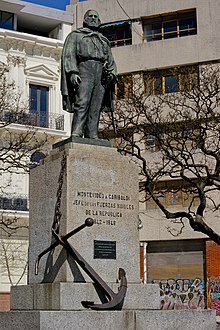
Back Italouruguaians Catalan Inmigración italiana en Uruguay Spanish Italo-uruguaiani Italian Imigração italiana no Uruguai Portuguese
 A monument of Italian general Giuseppe Garibaldi in the capital city of Montevideo, considered an important contributor towards the independence of Uruguay. | |
| Total population | |
| c. 90,000 (by birth, 2012)[1] c. 1,500,000 (by ancestry) 44% of Uruguay's population[2] | |
| Regions with significant populations | |
| Throughout Uruguay (primairly within Montevideo) | |
| Languages | |
| Rioplatense Spanish · Italian
(including different dialects and variations of the Italian language and pidgins such as Cocoliche and Lunfardo) | |
| Religion | |
| Christianity (predominantly Catholicism)
(minor Christian denominations practiced including Protestantism and Evangelicalism; Judaism is also relevant within the community) | |
| Related ethnic groups | |
| Italians · Italian Argentines Italian Americans, Italian Argentines, Italian Bolivians, Italian Brazilians, Italian Canadians, Italian Chileans, Italian Colombians, Italian Costa Ricans, Italian Cubans, Italian Dominicans, Italian Ecuadorians, Italian Guatemalans, Italian Haitians, Italian Hondurans, Italian Mexicans, Italian Panamanians, Italian Paraguayans, Italian Peruvians, Italian Puerto Ricans, Italian Salvadorans, Italian Venezuelans |
Italian Uruguayans (Italian: italo-uruguaiani; Spanish: ítalo-uruguayos or tanos in Rioplatense Spanish) are Uruguayan-born citizens who are fully or partially of Italian descent, whose ancestors were Italians who emigrated to Uruguay during the Italian diaspora, or Italian-born people in Uruguay.
Outside of Italy, Uruguay has one of the highest percentages of people of Italian descent in the world. It is estimated that approximately 44% of the total population of Uruguay—around 1,500,000 people—are of Italian ancestry. Furthermore, as of recent estimates, there are around 90,000 Italian citizens residing in Uruguay.[2] Italian emigrants began to arrive in Uruguay in large numbers in the 1840s and this migratory flow continued until the 1960s.[3][4]
The population of Italian origin, alongside that of the Spaniards, is often regarded as the foundational pillar of modern Uruguayan society. These two groups significantly contributed to the country's economic, social, and cultural development. Italian immigrants played a pivotal role in the growth of Uruguay, particularly in the late 19th and early 20th centuries, during a period of rapid industrialization and urbanization. Their influence can still be seen in various aspects of Uruguayan life, from cuisine and architecture to art and music.[1][5][6][7] Uruguayan culture bears important similarities to Italian culture in terms of language, customs, and traditions.[4]
- ^ a b "Numero iscritti suddivisi per ripartizioni estere" (in Italian). Retrieved 13 February 2018.
- ^ a b "Los árboles sin raíces, mueren" (in Spanish). Archived from the original on 4 March 2016. Retrieved 19 June 2014.
- ^ Tron, Ernesto; Ganz, Emilio H (1958). Historia de las colonias valdenses sudamericanas en su primer centenario, 1858-1958 (in Spanish). Librería Pastor Miguel Morel.
- ^ a b Pi Hugarte, Renzo (9 October 2001). "Elementos de la cultura italiana en la cultura del Uruguay" (PDF) (in Spanish). Archived from the original (PDF) on 21 August 2017. Retrieved 20 August 2017.
- ^ Arocena & Aguiar 2007, p. 22
- ^ Bengochea, Julieta (June 2014). "Inmigración reciente en Uruguay: 2005 - 2011" (PDF). Serie tesis de maestría en demografía y estudios de población (in Spanish). Facultad de Ciencias Sociales: 57-58. ISSN 2393-6479. Archived from the original (PDF) on 11 August 2018. Retrieved 11 August 2018.
- ^ Arocena & Aguiar 2007, p. 40